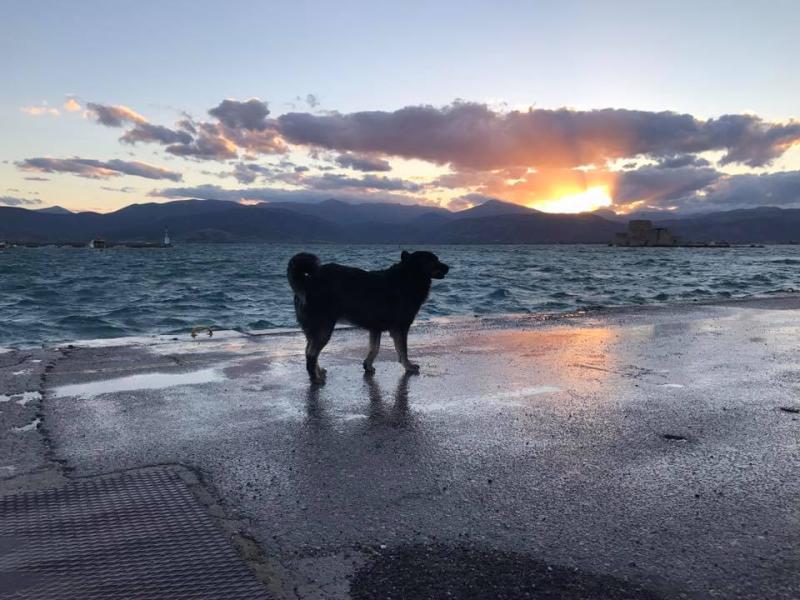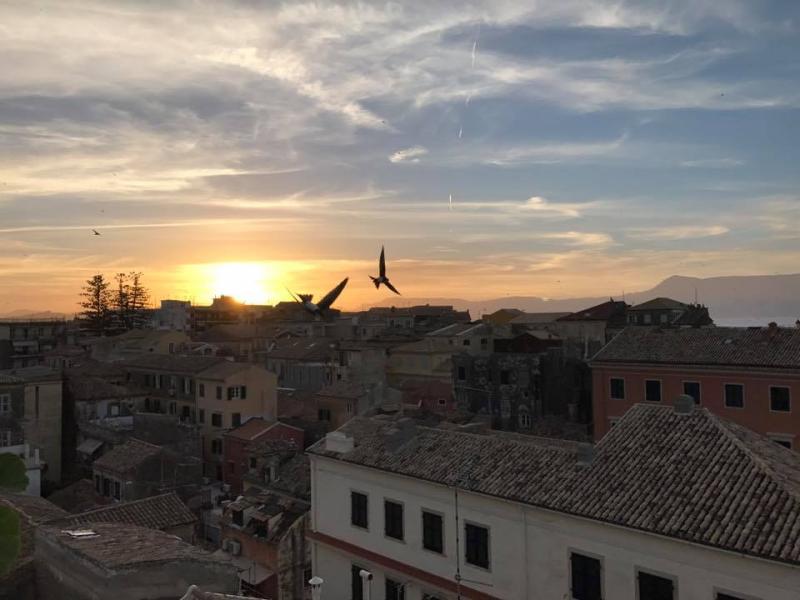Literary Locations–Greece: Meshing Myth with Modernity
He opened his mouth and out poured a flood of water. He then reached into his pockets and pulled out handfuls of gravel, sand and dirt and repeatedly rubbed them on his face and chest. Next to him stood another man, screaming. A woman near the back of the stage broke out in a disturbing song, wailing in a minor key. Suddenly, another woman appeared stage left, pushing boulders out toward the rest of the performers. In unison, they each stepped on the rocks and stood there, silent, staring at the audience.
We thought we were in for a night of classic German opera, but instead we got Lenz, a jarring contemporary chamber performance. Because it was in Greek, however, it wasn’t until long after that we learned what we had actually seen: the operatic telling of a schizophrenic poet spurned in love. The sense of amazement we experienced in that black box theatre remained with us throughout the ten days our Literary Locations class toured Greece, exploring new terrains of every sort.
COLUMBUS
Rewind to January when, instead of sitting in a black box theater in the back of an Athenian cafe, we were sitting in 250 Denney Hall discussing what Greece brought to our minds: democracy, architecture, the Olympics, mythology, olives and feta. The usual. In the semester that followed, professor Jennifer Higginbotham pushed us to think beyond these surface-level ideas by analyzing representations of Greece over millennia. The class was a veritable potpourri of Greek literature, covering everything from ancient works like The Odyssey and Lysistrata to modern pieces written in English which were often from the perspective of a cultural outsider in Greece. After finals, we departed Ohio State with our suitcases and blank journals in hand, filled with questions that only Greece could answer.
ATHENS
The class reconvened in Athens––the land where tzatziki sauce flows and marble steps crumble underfoot like blocks of fresh feta. In this Hellenic metropolis, the past intertwines with the present at all times: the Acropolis looms high above the zooming motorbikes, and ancient ruins lurk under glass floors in gelato shops and between marmalade-colored houses. Our time in Athens was divided evenly between both—exploring the history and experiencing the present.
There’s a reason the ideas of mythology remain so closely associated with the country. Greeks are extremely proud of their history––so proud that they engrain it in their everyday lives. Whether it be the “Achilles Hotel” where we stayed or locals hanging up talismans to protect them from the “evil eye,” Greeks wear their heritage boldly and, as we found out, are always excited to talk about it. Our tour guide Katarina was no exception.
Katarina led us across the Greek mainland and Peloponnese, explaining the history, society and agriculture of Greece for long bus rides throughout bustling Athens, sleepy villages and mesmerizing mountainsides. Her Greece was full of magic realism—she wove the gods and monsters of ancient mythology into modern Greece as a means of explaining the supernatural or impossible as factual. Before we knew it, we were referencing places as “the spot where Athena planted the first olive tree” or “the river Odysseus sailed to get to the River Styx” or “the cave in which Persephone was abducted.”
We found ourselves looking for the gods everywhere and, to our surprise, we found them—often in the most unlikely of places. We explored the streets of Athens’ Plaka district, colorful and kitschy and filled with stray cats who may or may not have been avatars of ancient gods and goddesses. Friendly stray dogs roamed the streets, and passersby readily shared scraps with them. Animals are essential to Greece—sheep and goats in the mountains, dolphins in the sea, birds swooping over the rooftops and the countless stray dogs and cats roaming the streets, the beaches and everywhere in between.
“Do you think if you walked where those people walked you’d see the gods?”
“Maybe. But I don’t think people’d know that was what they’d seen.”
—Neil Gaiman, American Gods
Modern, monotheistic notions of the divine separate humanity from what is typically considered godlike. This was not always the case for religions in general, however. Oral and written traditions provide abundant examples of these gods walking among human beings for a purpose, or even just for kicks. Neil Gaiman’s American Gods examines this phenomenon and asks, What if this still happened in the modern world? Would it be possible? Could humanity accept the intervention of the divine or would we, in the age of technology and skepticism, reject the presence of a deity even if it stood in front of us and declared its name?
When we arrived in Greece, we did not expect to see Zeus riding the subway or Athena riding a bike in Syntagma Square or Dionysus eating falafel. However, we did suddenly find ourselves in a land where the gods had once walked among men, and so we opened our eyes to the possibility of unearthly influences in the world around us.
DELPHI
From Athens, we headed into the mountains toward Delphi. The road was tricky, winding around the cliffs as we ascended, forcing the bus driver to make some deft maneuvers to keep the bus upright and avoid collisions with other vehicles, people and goats. The archeological site was nestled snugly on the mountain’s face, overlooking a valley rich with olive trees and yellow blossoms. We hiked through the pine trees, following the path vertically through marble ruins spongy with holes and speckled with craters left by ancient battles and the pummeling of a thousand years of natural forces. Katarina reminded us of the site’s history; with her narration, a simple holey rock became the pedestal of the Pythia—a chosen priestess possessed with the spirit of Apollo who could answer questions and deliver prophecies.
NAFPLIO
We left Athens and headed west. One evening, in the city of Nafplio, we were making our way to dinner when a dog trotted up to us, begging for attention. He led us around town until we found our dinner spot and then sat alongside us while we ate. As we enjoyed our entrees, a pack of dogs approached us—no doubt acting out an age-old feud between rivals. Jason—we christened him—stood his ground, protecting us. Later that night, we walked out to the docks where one could view the sunset shimmering on the sea and the islands and forts protruding from the waters. Ten of us locked arms and formed a human knot that we spent half an hour attempting to untangle. Our laughter bounced off the water and up into the clouds, ringing in our ears and swirling over the docks.

PREVEZA
We continued northwest through the country, stopping at archeological sites and other attractions along the way. As we did so, Katarina and professor Higginbotham married sights to myths, personal anecdotes and books we read in class. We toured literary sites including the river Acheron, which the Greeks say is one of the five rivers leading to the Underworld. According to Virgil, it is also the principal river of Tartarus. Even Dante’s Inferno claims that the Acheron borders Hell. As we floated downstream, past drooping tree branches that scraped the river’s surface, professor Higginbotham read to us from Homer’s The Odyssey.
“Beach your vessel hard by the Ocean’s churning shore and make your own way down to the moldering House of Death. And there into Acheron, the Flood of Grief, two rivers flow, the torrent River of Fire, the wailing River of Tears that branches off from Styx, the Stream of Hate, and a stark crag looms where the two rivers thunder down and meet.”
—Homer, The Odyssey (trans. Robert Fagles)

CORFU
It was time to depart from the mainland. The dark coastline, speckled with brightly-colored buildings, faded into the fog. Soon, Homer’s “wine-dark sea” surrounded us on all sides. The ferry sliced through the water and chilly air, but soon we were able to see the silhouette of another shore—Corfu. As we docked, the sun broke through the silver clouds and warmed our skin. We loaded onto the next bus and drove through the timeworn town, passing through the newer metropolitan areas strewn with boutiques and bars and into Old Town. Our hotel was perched near the cliffside which faced the venerable Venetian fortress and churning sea. The climate had changed from the dry heat of the Greek mainland into a damp riviera warmth.
We spent our time on Corfu trekking from one coast to the next via the steep hills that crowned the center of the island. We visited beaches, churches, museums and even a donkey sanctuary. The land was steeped in the various cultures that held control of the island over time—the Byzantines, Venetians, British and Germans—drenched in olive oil and kumquat liqueur.
On our last night in Corfu, the last night of our trip, we ate dinner on the rooftop of the Cavalieri Hotel. The sky faded from bright blue to a paler purple, and as the sun sunk below the horizon, the air warmed until everything—sea, sky, skin—was flushed pink. Birds swooped wildly overhead, weaving between the bell towers, crumbling ruins and majestic monuments. Beneath the crown of birds and rosy sky, we ordered our final chocolate soufflé.

By Madalynn Conkle, Michaela Corning-Myers and Avery Samuels
